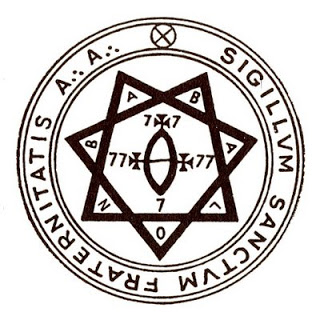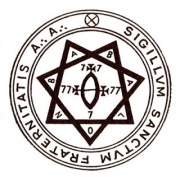
Do what thou wilt shall be the whole of the Law.
Introduction
In Thelema, the term “initiation” is used often and in varying ways. This essay is intended to elucidate the basic meaning and fundamentals of initiation, especially in the context of spiritual system of Thelema.
Basic definition: “Initiation” essentially refers to the path of spiritual progress of every individual. The “path of initiation” is synonymous with other terms such as “the path of attainment” or “the quest for enlightenment.” It is sometimes called the Great Work, or “climbing the Tree of Life,” or simply “the Path.”
Along the path, one reaches various “degrees” of initiation which can be construed as certain levels of insight or understanding or simply certain shifts in one’s awareness that move progressively from the ignorance of the mundane view of self and the world to the “initiated” or enlightened view. These “degrees” of initiation refer strictly to an internal process, and the ceremonies and “degrees” of temporal organizations can only be a symbolic reflection of one’s inner initiations. As Crowley wrote, “The Master Therion warns all Aspirants to the Sacred Wisdom and the Magick of Light that Initiation cannot be bought, or even conferred; it must be won by personal endeavor” (letter to W.T. Smith, 1934 e.v.).
This leads to some general principles of initiation that are true across all forms of spirituality:
1) Initiation can ultimately only come from the endeavors and work of the individual.
2) True initiation is always in the form of the direct experience of the individual.
3) Initiation cannot be bestowed from others through words, symbols, rituals, or any other way. The most another can do is help point the way and aid one to avoid common pitfalls.
Initiation in General
The basics of initiation are explained fairly succinctly in a text called Liber LXI vel Causae or simply Liber Causae. It reads:
“In all systems of religion is to be found a system of Initiation, which may be defined as the process by which a man comes to learn that unknown Crown.”
This establishes that all systems of religion have some form or another of approaching the same Truth. They all contain some form of “the process by which a man comes to learn that unknown Crown,” which is here called “Initiation.” The “unknown Crown” is a Qabalistic reference to the first Sephirah on the Tree of Life, Kether, which literally means “Crown” and represents the Unity of Godhead to which man may attain. Some have called this “unknown Crown” the term “God,” some have called it “liberation,” or “unity,” or “Truth,” and countless other names. Ultimately, it is “unknown” and nameless because it is beyond the dualities of knower and known, beyond the dualities of the subject and object of language, and therefore cannot be accurately named. It is, to use the language of the Gnostic Mass, always “beyond speech and beyond sight.” Initiation is defined as the process whereby one may come to learn That. Liber Causae continues:
“Though none can communicate either the knowledge or the power to achieve this, which we may call the Great Work, it is yet possible for initiates to guide others.”
Here we are told what was mentioned above as a general principle of initiation: Initiation cannot be bestowed from others through words, symbols, rituals, or any other way. “None can communicate” does not mean there is not anyone smart or enlightened enough to communicate this Truth, but it is a Truth whose nature is simply incommunicable by virtue of it being beyond all names, forms, signs, and symbols.
Here we also see the process of “Initiation” being equated with the term “the Great Work,” as mentioned previously as well. We also learn that initiates may not communicate “that unknown Crown” but they can guide others toward it. Liber Causae continues on this theme:
“Every man must overcome his own obstacles, expose his own illusions. Yet others may assist him to do both, and they may enable him altogether to avoid many of the false paths, leading no whither, which tempt the weary feet of the uninitiated pilgrim. They can further insure that he is duly tried and tested, for there are many who think themselves to be Masters who have not even begun to tread the Way of Service that leads thereto.”
Here we have affirmation of another general principle of initiation mentioned before: Initiation can ultimately only come from the endeavors and work of the individual. We also learn that the path of initiation must involve overcoming obstacles and exposing one’s illusions about reality. As another important foundational text says, “Thou then who hast trials and troubles, rejoice because of them, for in them is Strength, and by their means is a pathway opened unto that Light… Rejoice therefore, O Initiate, for the greater thy trial the greater thy Triumph” (Liber Librae).
There is a reaffirmation of the fact that initiates may help guide others in order to enable them to not fall into common pitfalls. There is also an assertion that “there are many who think themselves to be Masters” who are not even close, “Masters” being a name for those who have succeeded in treading the Path. Those who “think themselves to be Masters” includes people who earnestly may think they have attained but have only obtained minor glimpses of truth as well as those who may be called “charlatans” insofar as they knowingly prey upon earnest seekers by deception and manipulation.
One thing that is particularly striking is the mention that “the Way of Service” is what “leads thereto,” i.e. to becoming a Master. There are several ways to understand what is meant by “the Way of Service” that are all connected. Firstly, there is the fact which has already been mentioned repeatedly: one function of initiates is to be a guide to others on the path. In many systems, once one has become judged to be sufficiently advanced in understanding (or “attainment” or any other similar term), one becomes a teacher or guide to others – there are many traditions that involve the “transmission” of wisdom from guru or Master to disciple, from the initiated to uninitiated.
Related to this way of understanding “the Way of Service” is the fact that, especially within Thelema, there is an emphasis on “coming back to the world” once one has attained. This is virtually identical to the bodhisattva vow in Mahayana Buddhism whereby one swears to return from nirvana (liberation, attainment, etc) back to samsara (the mundane world of ignorance) in order that all beings may be liberated. There are plentiful examples within the Western tradition of this same idea, often involving the symbolism of someone who has attained returning from a distant and/or isolated place; prominent examples include returning from a mountain (e.g. Moses, Muhammad, and Nietzsche’s Zarathustra) as well as returning from the wilderness (e.g. Jesus). That is, becoming a Master is tied up in the Way of Service for one does not become a Master solely for enlightening oneself but also to help others attain to the Light.
Finally, connected to these other two ways of understanding “the Way of Service,” one can understand this Service in a more general sense: it requires a diminishing of one’s attachment to the ego, the personal identity or sense of self, and one cannot become a Master if one clings to this self with its self-oriented goals. In all systems of attainment, one seeks the “unknown Crown” which is always beyond the personal sense of self or “ego”; it is, to use the language of the Gnostic Mass again, “Thou who art I beyond all I am.” It should be noted that in none of these ways of understanding the Way of Service is there any semblance of “servility,” of abasing oneself before others or self-denigration: it is a Service of strength, of one who overflows with Light and so bestows it upon others that they may partake of it.
“Now the Great Work is one, and the Initiation is one, and the Reward is one, however diverse are the symbols wherein the Unutterable is clothed.”
This is an especially important point: essentially, initiation always leads to the One, to “that unknown Crown,” to “the Unutterable.” The mystics and initiates of all times have spoken of the same “Great Work,” but everyone has used different symbols and language to explain it. In a Holy Book of Thelema it is written, “There must ever be division in the word. For the colours are many, but the light is one” (Liber LXV). This is a beautiful image where the Light, the “Unutterable,” is always One, but it enters through the prism of the world and each individual who speaks about it represents one color among many. There must always be a diversity of expression, but they are all facets pointing to the one Light. An identical idea is expressed in another Holy Book of Thelema where it is written:
“To you who yet wander in the Court of the Profane we cannot yet reveal all; but you will easily understand that the religions of the world are but symbols and veils of the Absolute Truth. So also are the philosophies. To the adept, seeing all these things from above, there seems nothing to choose between Buddha and Mohammed, between Atheism and Theism” (Liber X).
The Mysteries in the New Aeon
It is understood that there is a single Light, “the Absolute Truth,” “the Unutterable,” et cetera, and the diversity of expression are simply different ways to symbolize and veil that Unity. In Thelema, there is a further understanding that there are different “formulas” of initiation or attainment that are efficacious in one time but that need to be updated for a new era or “aeon.” A virtually identical notion is held in the Hindu doctrine of the “yugas” or epochs (e.g. the Kali Yuga) where the requirements to attain liberation change with each “yuga.” This is the essential meaning behind the idea that we are in a “New Aeon.” Let’s look into this idea in more depth:
In the world of Western esotericism or “occultism,” there is a certain symbolic way that the “Mysteries” of the path of initiation are explained. In general, there are a series of ceremonial rituals which each candidate undergoes, symbolizing the stages of illumination and offering guidance on the Path. Most importantly, there is a “Hierophant” (literally meaning “one who reveals sacred things”) whose purpose is to serve as the dispenser of the Mysteries. Ultimately, this Hierophant represents or reflects the God within each individual who is the true Hierophant of every initiate.
In one esoteric tradition, that of the Hermetic Order of the Golden Dawn, the Path was symbolized in various psycho-dramas of the various “degrees” of initiation. The Hierophant sat in the East, the place of the rising Sun, while other officers sat in other quarters. This Hierophant not only dispensed the Mysteries as the “initiator” but also represented the “formula” of the Mysteries themselves. In this system, the Hierophant was represented as Osiris, a god who underwent death and was resurrected in a more “divine” form. This essentially means that attainment was achieved through a life-death-resurrection process, the “formula” of Osiris. This, of course, includes the formula represented by the death and resurrection of Christ who is seen as one expression of the “Osirian” formula (along with Attis, Adonis, Dionysus, et cetera).
In something called the “Ceremony the Equinox,” the various officers rotate around the room, taking on new offices with a new individual becoming the Hierophant. In the same way, there was an “Equinox of the Gods” where the gods themselves shifted their positions: Osiris no longer represented the formula of initiation. This is why the era or aeon where his formula was active is called the “Aeon of Osiris” or the “Aeon of the Dying God.” Now Horus sat in the East as the Hierophant and a new formula of attainment was put in place: “the word of the Law is Thelema” (AL I:39). This is the symbolism at work in The Book of the Law when it is written, “Abrogate are all rituals, all ordeals, all words and signs. Ra-Hoor-Khuit hath taken his seat in the East at the Equinox of the Gods… Hoor in his secret name and splendour is the Lord initiating” (AL I:49). In Thelema, this Equinox of the Gods is said to have occurred on the Vernal Equinox of 1904, with the new Book of the Law – a new Law for a new aeon – being received a few days afterward. Crowley comments on this verse of The Book of the Law:
“This verse [AL I:49] declares that the old formula of Magick — the Osiris-Adonis-Jesus-Marsyas-Dionysus-Attis-et cetera formula of the Dying God – is no longer efficacious. It rested on the ignorant belief that the Sun died every day, and every year, and that its resurrection was a miracle. The Formula of the New Aeon recognizes Horus, the Child crowned and conquering, as God. We are all members of the Body of God, the Sun; and about our System is the Ocean of Space. This formula is then to be based upon these facts. Our ‘Evil’, ‘Error’, ‘Darkness’, ‘Illusion’, whatever one chooses to call it, is simply a phenomenon of accidental and temporary separateness. If you are ‘walking in darkness’, do not try to make the sun rise by self-sacrifice [i.e. the formula of Osiris], but wait in confidence for the dawn, and enjoy the pleasures of the night meanwhile. The general allusion is to the Equinox Ritual of the G[olden] D[awn].”
There are many aspects of the path of initiation that have changed – or rather, are better understood – in the New Aeon. A more in-depth look into the major aspects that have changed is given in the series of essays “New Aeon Initiation.” What is notable in Thelema is the understanding that the Law of this Aeon will shift again in the future: Thelema is for this Aeon and a new Law will come about when there is another shift, another “Equinox of the Gods.” This is what is spoken to in another line of The Book of the Law:
“But your holy place shall be untouched throughout the centuries: though with fire and sword it be burnt down & shattered, yet an invisible house there standeth, and shall stand until the fall of the Great Equinox; when Hrumachis shall arise and the double-wanded one assume my throne and place. Another prophet shall arise, and bring fresh fever from the skies; another woman shall awake the lust & worship of the Snake; another soul of God and beast shall mingle in the globèd priest; another sacrifice shall stain the tomb; another king shall reign; and blessing no longer be poured To the Hawk-headed mystical Lord!” (AL III:34).
There will be a “fall of the Great Equinox” and, instead of Horus, the god “Hrumachis” will arise, and a new god – “the double-wanded one” – will be installed in the East as Hierophant with a different “formula” for a new aeon. Crowley comments, “Hrumachis is the Dawning Sun; he therefore symbolizes any new course of events.” Therefore “Hrumachis shall arise” is another way to say the light of a new aeon will come. Crowley continues, “The ‘double-wanded one’ is ‘Thmaist of dual form as Thmais and Thmait’, from whom the Greeks derived their Themis, goddess of Justice.” Crowley is referring to Thmaist as an officer of the Golden Dawn ceremonies; Thmaist is identical to the Greek “Themis” and the Egyptian “Maat” or simply “Ma,” all gods of Justice and balance. Crowley continues, “Following him [Horus] will arise the Equinox of Ma, the Goddess of Justice, it may be a hundred or ten thousand years from now; for the Computation of Time is not here as There… Strength will prepare the Reign of Justice. We should begin already, as I deem, to regard this Justice as the Ideal whose Way we should make ready, by virtue of our Force and Fire.”
Summary
Initiation is the process whereby we come to the one Light, the “unknown Crown” within each of us. It can only be attained through our own efforts, although other initiates and adepts may guide us to point the way and help avoid common pitfalls.  There is a single Light, although it is expressed in many different ways; it is the same Light regardless of belief or tradition. The old initiatory formula of Osiris became no longer efficacious with the dawning of the New Aeon of Horus whose word of the Law is Thelema. Further details of the nature of initiation in this New Aeon can be explored in the series “New Aeon Initiation.” In the distant future, the Aeon of Horus will itself end and a new god, that of Justice, will arise with a new Law.
There is a single Light, although it is expressed in many different ways; it is the same Light regardless of belief or tradition. The old initiatory formula of Osiris became no longer efficacious with the dawning of the New Aeon of Horus whose word of the Law is Thelema. Further details of the nature of initiation in this New Aeon can be explored in the series “New Aeon Initiation.” In the distant future, the Aeon of Horus will itself end and a new god, that of Justice, will arise with a new Law.
Love is the law, love under will.

If you enjoy these writings, please consider pledging $1+ on my Patreon



